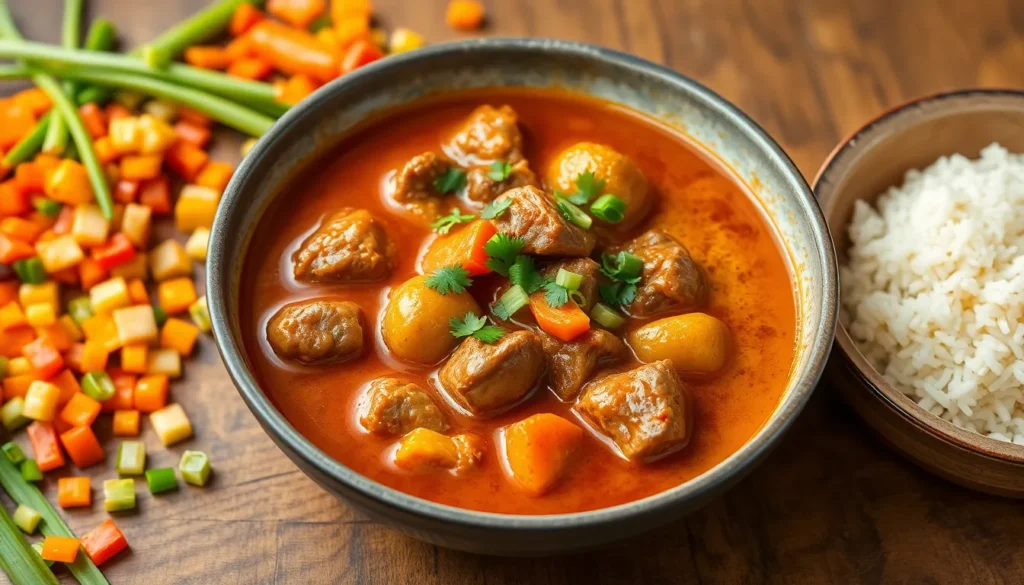Chinese beef curry transforms tender chunks of beef into a fragrant masterpiece that’ll make your kitchen smell absolutely incredible. We’ve perfected this recipe to deliver restaurant-quality flavors right from your home stovetop using simple ingredients you can find at any grocery store.
This isn’t your typical Indian curry – Chinese beef curry brings its own unique blend of aromatic spices and cooking techniques that create something truly special. The secret lies in the perfect balance of soy sauce depth and warming curry spices that coat every piece of melt-in-your-mouth beef.
We’re sharing our foolproof method that guarantees tender meat and a rich sauce every single time. Whether you’re craving comfort food or want to impress dinner guests this Chinese beef curry recipe delivers maximum flavor with minimal fuss.
Ingredients
We’ve carefully selected each ingredient to create the perfect balance of flavors in our Chinese beef curry. These simple pantry staples and fresh ingredients come together to deliver authentic taste and tender texture.
For the Beef
- 2 pounds beef chuck roast, cut into 2-inch cubes
- 2 tablespoons cornstarch
- 1 tablespoon soy sauce
- 1 teaspoon salt
- 1/2 teaspoon white pepper
- 2 tablespoons vegetable oil for marinating
For the Curry Base
- 3 tablespoons Chinese curry powder
- 2 tablespoons tomato paste
- 1 large onion, sliced thick
- 4 cloves garlic, minced
- 1 inch fresh ginger, grated
- 2 tablespoons vegetable oil
- 3 cups beef broth
- 1 cup coconut milk
- 2 tablespoons oyster sauce
- 1 tablespoon dark soy sauce
- 1 teaspoon sugar
- 1/2 teaspoon salt
For the Vegetables
- 3 medium potatoes, peeled and cut into chunks
- 2 large carrots, cut into thick rounds
- 1 red bell pepper, cut into strips
- 1 cup fresh or frozen peas
For the Garnish
- 2 green onions, chopped
- Fresh cilantro leaves
- Steamed jasmine rice for serving
Equipment Needed
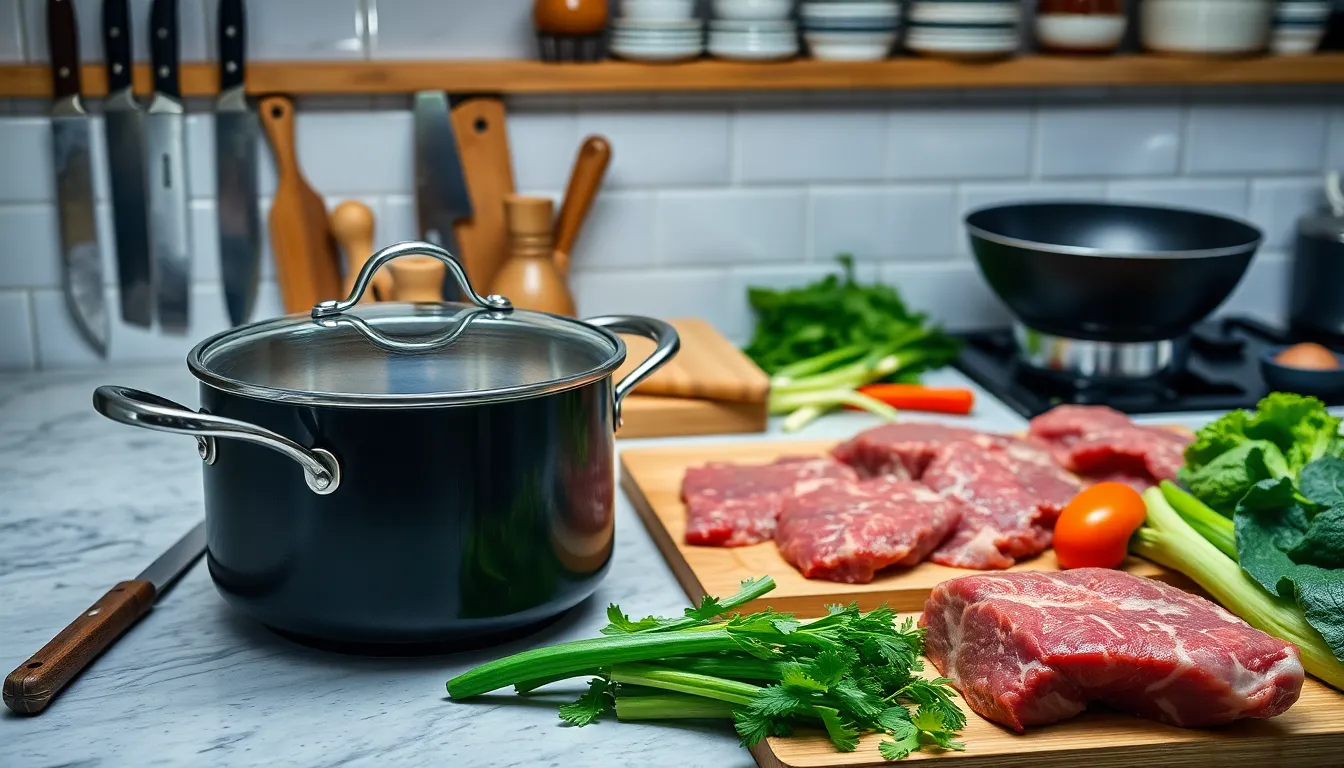
Creating authentic Chinese beef curry requires the right equipment to achieve that perfect balance of tender meat and rich sauce. We recommend investing in quality cookware that will distribute heat evenly and maintain consistent temperatures throughout the cooking process.
Heavy-Bottomed Pot or Dutch Oven
The most crucial piece of equipment for this recipe is a heavy-bottomed pot or Dutch oven. These vessels provide even heat distribution and are essential for the slow cooking process that transforms tough beef cuts into tender morsels. Cast iron pots work exceptionally well for this purpose, while thick-bottom stainless steel pots also deliver excellent results.
Stir-Fry Pan or Wok
If you prefer the stir-fry method for your Chinese beef curry, a good wok or large stir-fry pan becomes indispensable. These allow for quick cooking at high temperatures while maintaining the authentic texture and flavor profile of restaurant-style curry.
Essential Kitchen Tools
| Tool | Purpose |
|---|---|
| Sharp knives | Cutting beef into uniform cubes and chopping vegetables |
| Cutting board | Safe preparation surface for all ingredients |
| Measuring spoons | Accurate spice and seasoning portions |
| Mixing bowls | Marinating beef and organizing ingredients |
| Wooden spoon | Stirring without scratching cookware surfaces |
Additional Helpful Equipment
A good set of tongs makes browning beef pieces much easier and safer. We also find that having a ladle on hand helps when serving the curry over rice. For those who prefer precise measurements, a kitchen scale ensures consistent results every time you make this dish.
The beauty of Chinese beef curry lies in its accessibility. You likely already have most of these tools in your kitchen, making this recipe achievable without special equipment purchases.
Prep Work
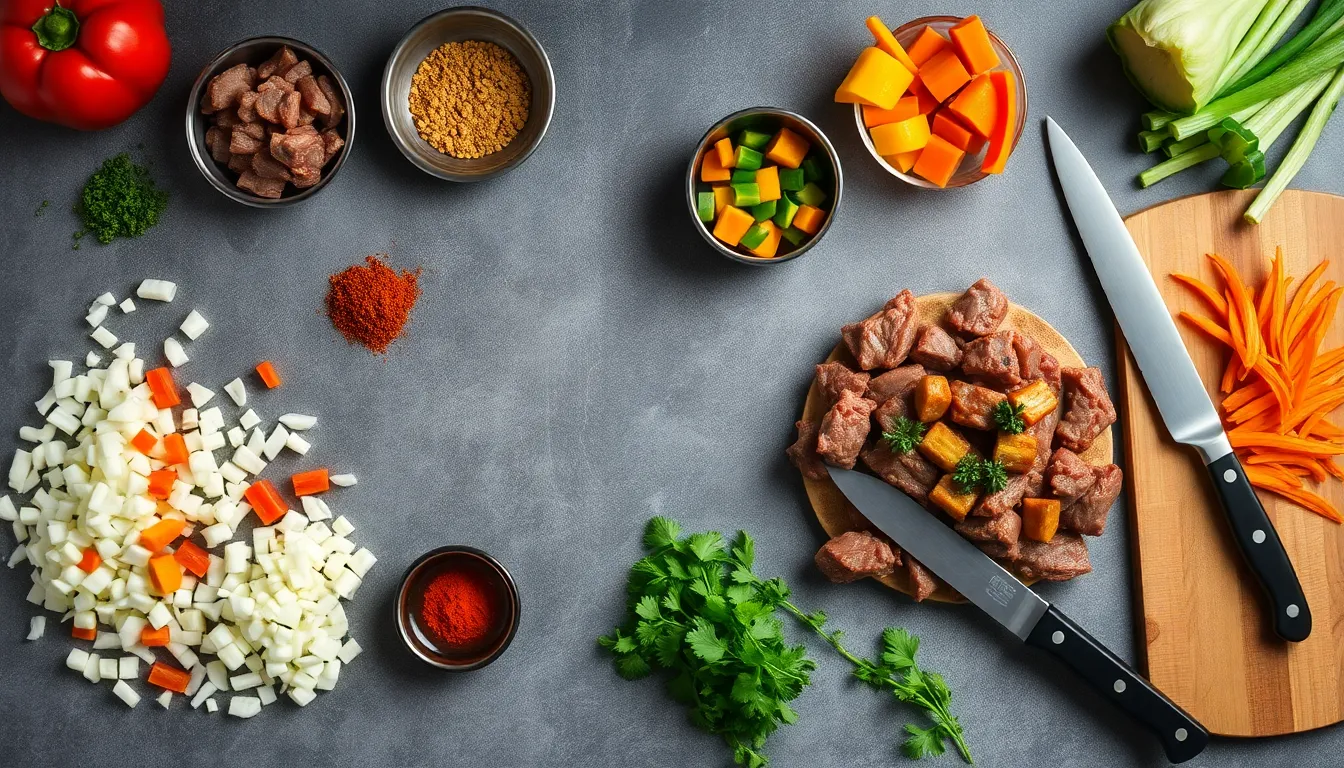
Proper preparation forms the foundation of our Chinese beef curry success. We’ll organize our ingredients and execute key prep steps to ensure smooth cooking and maximum flavor development.
Preparing the Beef
We start by cutting our beef chuck roast into uniform 1-inch cubes for even cooking. The blanching method proves essential for achieving restaurant-quality results. We bring a large pot of water to boil and add our beef chunks for 2-3 minutes to remove impurities that could cloud our curry sauce.
After blanching, we drain the beef thoroughly and pat it completely dry with paper towels. This step eliminates any residual moisture that might prevent proper browning. We then season our beef cubes generously with salt and pepper before coating them lightly with cornstarch.
The cornstarch coating serves dual purposes in our preparation. It helps create a golden crust when we brown the beef and later contributes to thickening our curry sauce naturally. We allow the coated beef to rest for 10 minutes at room temperature before cooking begins.
Preparing the Vegetables
We dice our onions into uniform pieces roughly the same size as our beef cubes. This ensures even cooking throughout the curry. Our potatoes get peeled and cut into 1-inch chunks that will hold their shape during the long simmering process.
Carrots require similar treatment with diagonal cuts that create attractive pieces while maintaining structural integrity. We slice our bell peppers into strips that add color contrast and textural variety to the finished dish.
All vegetables should be prepped and organized in separate bowls before we begin cooking. This mise en place approach prevents overcooking any single ingredient and allows us to add components at their optimal timing. We keep our aromatics like garlic and ginger minced and ready for immediate use.
Making the Curry Paste
We create our curry base by combining Chinese curry powder with turmeric and Chinese five-spice powder in a small bowl. This dry mixture forms the flavor foundation of our curry sauce. We measure our liquids including beef stock, soy sauce, and coconut milk into separate containers for easy addition.
Our aromatics get prepared by mincing fresh garlic and ginger into a paste-like consistency. We also have our bay leaves and any optional lemongrass ready for infusion. The key lies in having everything measured and accessible before we heat our cooking oil.
For thickening our final sauce, we prepare a cornstarch slurry by mixing 2 tablespoons of cornstarch with 3 tablespoons of cold water. This mixture stays smooth when whisked thoroughly and prevents lumps from forming in our curry sauce. We keep this slurry stirred and ready for the final cooking stage.
Instructions
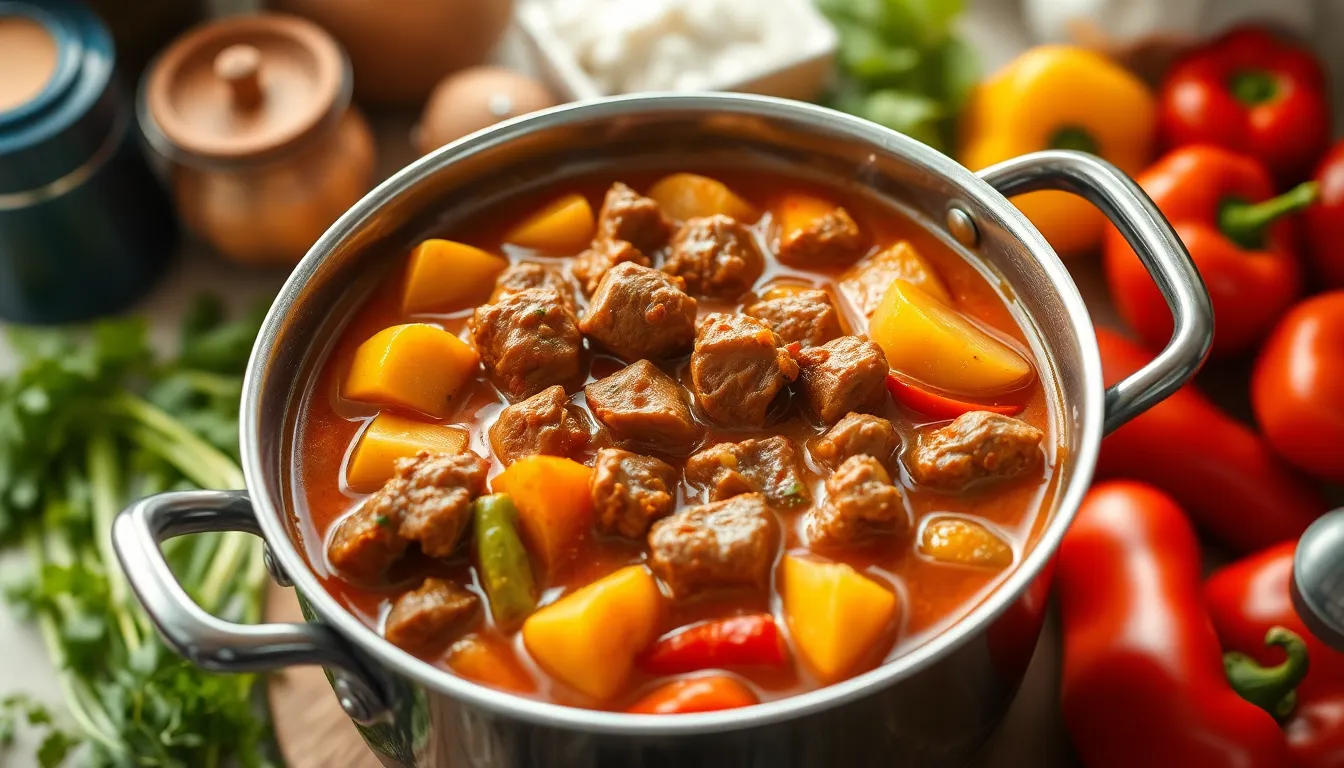
With our mise en place complete and all ingredients prepped, we’re ready to transform these components into an aromatic Chinese beef curry. Each step builds layers of flavor that create the signature taste profile of this beloved dish.
Marinating the Beef
We start by cutting our beef chuck roast into uniform cubes, approximately 1.5 inches in size for even cooking. For maximum tenderness, we lightly sprinkle the beef cubes with baking soda and let them marinate for 15 minutes. After the marination time, we thoroughly rinse the beef under cold water and pat it completely dry with paper towels. This tenderizing process helps break down the muscle fibers and ensures our beef becomes fork-tender during cooking.
Cooking the Aromatics
We heat 2 tablespoons of vegetable oil in our heavy-bottomed pot over medium-high heat until it shimmers. Once the oil is hot, we add our diced onions and minced garlic, stir-frying constantly for about 2 minutes until they become fragrant and slightly golden. The aromatics should sizzle immediately upon contact with the oil. We then add our sliced carrots and bell peppers to the pot, continuing to stir-fry for another minute to begin softening these vegetables.
Browning the Beef
We increase the heat to high and add our marinated beef cubes to the pot in a single layer, avoiding overcrowding. Working in batches if necessary, we sear the beef for 2-3 minutes without stirring, allowing each side to develop a golden-brown caramelized crust. We turn the beef pieces and continue browning all sides, which takes approximately 6-8 minutes total. This browning step creates the deep, rich flavor that distinguishes restaurant-quality curry from homemade versions.
Building the Curry Base
We reduce the heat to medium and add our Chinese curry powder blend directly to the pot, stirring constantly for 30 seconds until the spices become aromatic. Next, we slowly pour in the coconut milk while stirring to prevent the curry paste from clumping. We add our beef broth, Chinese cooking wine, soy sauce, and sugar, stirring thoroughly to combine all ingredients. The mixture should have a smooth, creamy consistency with no lumps of curry powder visible.
Simmering the Curry
We bring the curry mixture to a gentle boil, then reduce the heat to low and cover the pot. The curry needs to simmer for 20 minutes, allowing the beef to become tender and absorb the curry flavors. During this time, we stir occasionally to prevent sticking and ensure even cooking. The sauce should bubble gently rather than boil vigorously, which could toughen the meat.
Adding the Vegetables
We add our diced potatoes to the curry base, stirring gently to incorporate them without breaking up the tender beef. The curry continues to simmer covered for another 15-20 minutes until the potatoes are fork-tender and have absorbed the curry flavors. We check the vegetables periodically, ensuring they cook evenly and don’t become mushy. The carrots and bell peppers added earlier should now be perfectly tender.
Final Seasoning
We taste the curry and adjust the seasonings as needed, adding salt, white pepper, or additional curry powder to achieve our desired flavor balance. If the sauce appears too thin, we simmer uncovered for the final 5 minutes to allow it to reduce and thicken naturally. The finished curry should coat the back of a spoon and have a rich, golden color. We remove the pot from heat and let it rest for 2-3 minutes before serving over steamed jasmine rice.
Cooking Tips and Techniques
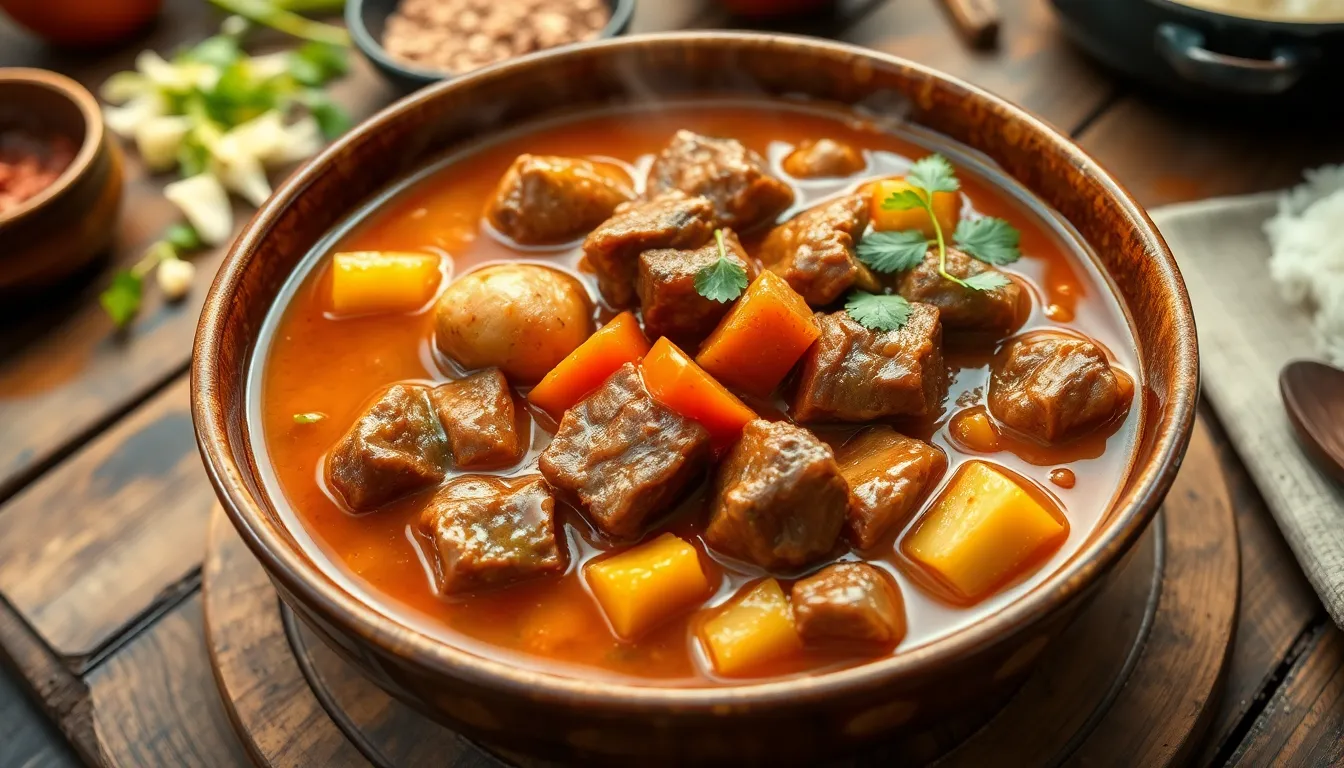
The difference between good Chinese beef curry and exceptional curry lies in mastering a few key techniques. We’ll share our proven methods to help you create restaurant-quality results every time.
Choosing the Right Cut of Beef
Chuck roast stands out as our top choice for Chinese beef curry due to its perfect balance of fat and connective tissue. We prefer this cut because it delivers tender, flavorful meat after proper simmering or braising. Traditional Cantonese versions often feature tendon-rich cuts, but we find these can become dry without careful preparation. Chuck roast consistently produces the juicy texture we want in our curry.
Slow-cook beef cuts work exceptionally well for this dish since they break down beautifully during the cooking process. We avoid lean cuts like sirloin or round steak because they tend to become tough and chewy. The marbling in chuck roast adds richness to our curry while the connective tissue melts during cooking to create natural thickening.
Achieving the Perfect Consistency
Our ideal Chinese beef curry has a stew-like consistency where the sauce coats the beef and vegetables while remaining saucy. We achieve this texture by using cornstarch slurry as our primary thickening method. Alternatively, we simmer the curry uncovered during the final minutes to reduce excess liquid naturally.
Coconut milk plays a crucial role in creating the right consistency while adding richness to our curry. We combine it with beef broth to balance texture and prevent the sauce from becoming too thick or too thin. The key is monitoring the consistency throughout cooking and adjusting as needed.
We recommend making our cornstarch slurry with equal parts cornstarch and cold water. This mixture integrates smoothly without creating lumps. We always add the slurry gradually while stirring to control the final thickness of our curry.
Balancing the Flavors
Chinese beef curry requires careful balance between multiple spice elements to achieve its distinctive taste profile. We blend curry powder and turmeric as our foundation, then enhance with Chinese five-spice and white pepper for authentic depth. This combination creates the complex flavor base that sets Chinese curry apart from other varieties.
Savory, sweet, and aromatic notes work together harmoniously in our curry. We incorporate soy sauce for umami richness, sugar to balance the spices’ intensity, and Chinese cooking wine for depth. Coconut milk softens the curry’s heat while providing creamy richness that mellows stronger flavors.
Fresh aromatics form the backbone of our flavor profile. We use garlic, shallots, and onion as our base trio, sometimes adding lemongrass for extra fragrance. These ingredients create layers of aroma that develop throughout the cooking process. We find that sautéing these aromatics properly releases their essential oils and maximizes their flavor contribution to our finished curry.
Serving Suggestions

We recommend serving our Chinese beef curry over steamed jasmine rice as the classic pairing that perfectly absorbs the rich curry sauce. The fragrant rice provides a neutral base that balances the bold spices and allows every flavor note to shine through. White rice works equally well if jasmine rice isn’t available in your pantry.
Our favorite presentation involves ladling the hot curry generously over individual bowls of rice. This method ensures each serving gets an equal distribution of tender beef chunks and perfectly cooked vegetables. We always make sure to include plenty of the aromatic sauce since it’s truly the star of the dish.
Simple vegetable sides complement this hearty curry beautifully without competing for attention. Steamed bok choy or Chinese broccoli adds a fresh green element that cuts through the curry’s richness. We often prepare these vegetables with just a touch of garlic and soy sauce to maintain the Chinese flavor profile.
Pickled vegetables make an excellent accompaniment that provides acidic contrast to the coconut milk’s creaminess. Quick pickled cucumber or daikon radish offers a refreshing crunch that cleanses the palate between bites of the rich curry. These pickles are particularly welcome when serving the dish on warm days.
We love garnishing each bowl with freshly chopped green onions and cilantro for added color and freshness. The herbs brighten the appearance while contributing subtle flavor notes that enhance the overall dining experience. A light sprinkle of sesame seeds adds an extra layer of texture and nutty flavor.
Leftovers actually improve in flavor as the spices continue to meld overnight in the refrigerator. We find that reheating portions gently on the stovetop with a splash of broth or coconut milk restores the perfect consistency. This makes our Chinese beef curry an ideal meal prep option for busy weekdays.
For special occasions we serve the curry family style in a large serving bowl alongside individual rice bowls. This presentation encourages sharing and creates a warm communal dining experience that celebrates the comfort food nature of this beloved dish.
Storage and Reheating Instructions
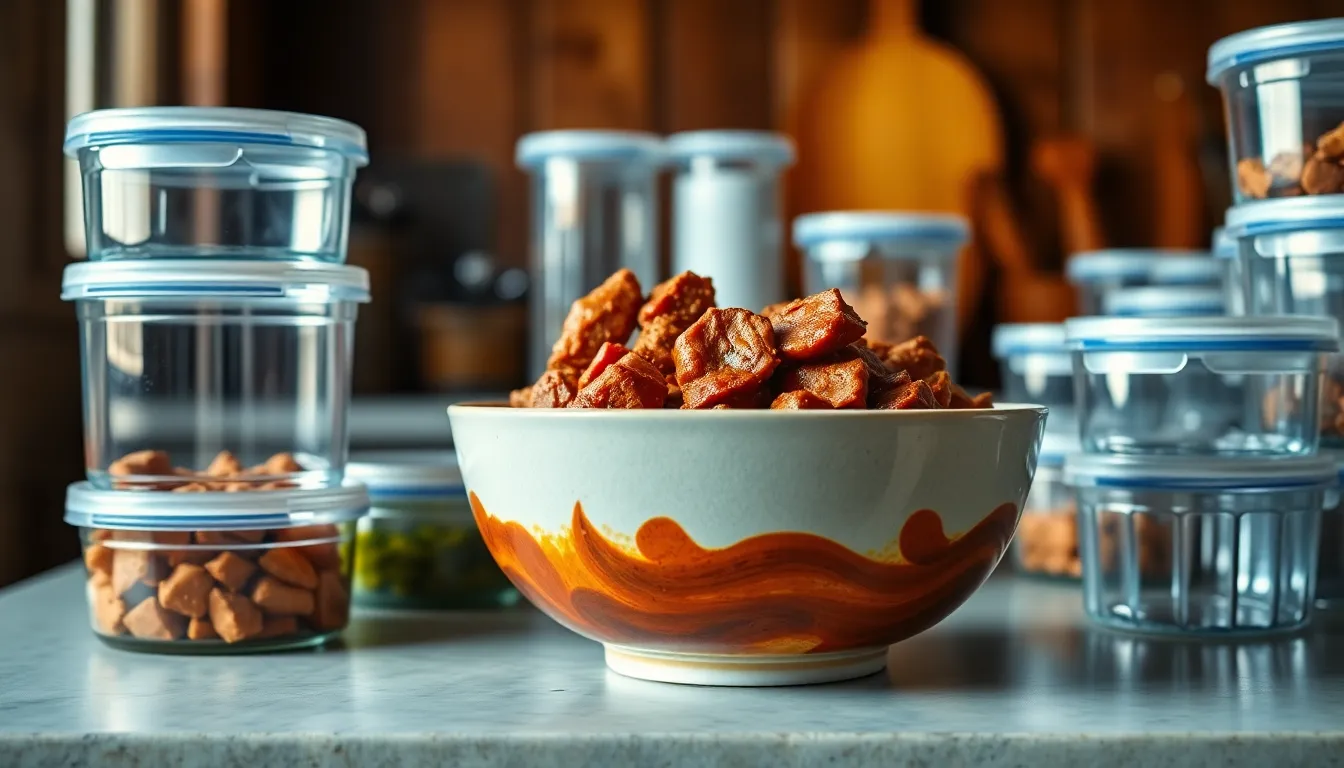
Proper storage keeps our Chinese beef curry fresh and flavorful for days after cooking. We store the cooled curry in airtight containers in the refrigerator where it stays safe for 3 to 4 days. The flavors actually improve during refrigeration as the spices continue to meld together.
Refrigerator Storage
We allow the curry to cool completely before transferring it to storage containers. Glass containers work best for maintaining freshness and preventing odor absorption. Our curry should be stored within two hours of cooking to ensure food safety.
| Storage Method | Duration | Container Type |
|---|---|---|
| Refrigerator | 3-4 days | Airtight containers |
| Freezer | Up to 2 months | Freezer-safe containers |
Freezer Storage
For longer storage we freeze the curry in freezer-safe containers for up to 2 months. We leave about an inch of headspace in containers to allow for expansion during freezing. Portioning the curry into individual serving sizes makes reheating more convenient.
Reheating from Refrigerated
We reheat refrigerated curry gently on the stovetop over medium-low heat. Stirring occasionally prevents sticking and ensures even heating throughout. Adding a splash of water or beef broth helps restore the sauce consistency if it has thickened during storage.
Reheating from Frozen
Frozen curry requires overnight thawing in the refrigerator for best results. We can also reheat directly from frozen using low heat and frequent stirring to prevent scorching. The reheating process takes longer when starting from frozen but produces equally delicious results.
Maintaining Quality During Reheating
We avoid overheating to preserve the tender texture of the beef and vegetables. The curry is properly reheated when it reaches steaming temperature throughout. Testing the center temperature ensures the entire portion is heated evenly before serving.
Recipe Variations
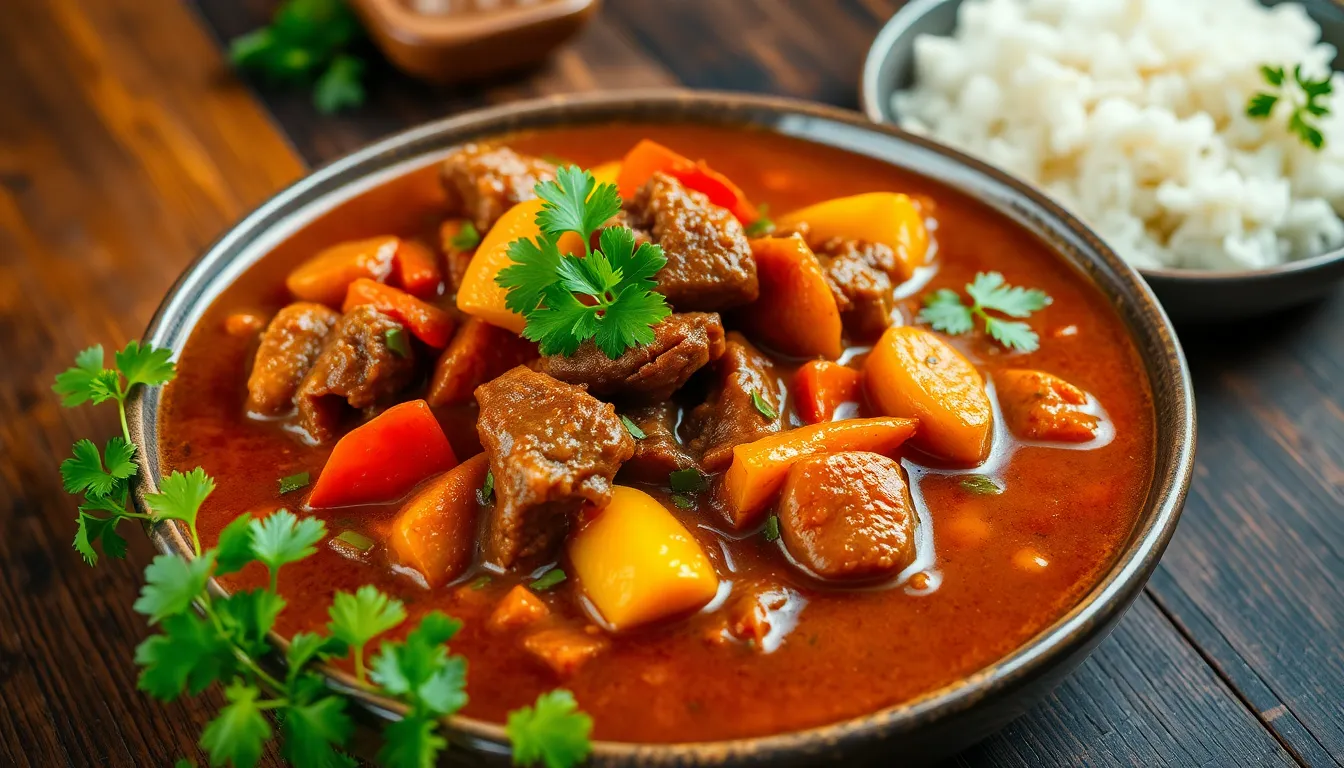
Our Chinese beef curry recipe serves as a versatile foundation that adapts beautifully to different flavor preferences and dietary needs. We can easily customize this dish by adjusting spice levels, enriching the sauce, or incorporating additional vegetables to create exciting new variations.
Spicy Chinese Beef Curry
We transform our base recipe into a fiery delight by increasing the curry powder content and adding bold heat elements. Incorporate an extra tablespoon of Chinese curry powder along with 1-2 teaspoons of chili paste or fresh sliced chili peppers during the sautéing stage. We recommend adding a pinch of white pepper and Chinese five-spice powder to create depth of flavor alongside the heat. For those who prefer a stir-fry style approach, we can use thinly sliced beef and crisp vegetables for a quicker cooking method that delivers intense spicy flavors in less time.
| Spice Addition | Amount | When to Add |
|---|---|---|
| Extra curry powder | 1 tablespoon | With aromatics |
| Chili paste | 1-2 teaspoons | During sautéing |
| White pepper | 1/2 teaspoon | With curry base |
| Chinese five-spice | 1/4 teaspoon | With other spices |
Coconut Chinese Beef Curry
We create a luxuriously creamy variation by incorporating 1 to 1.5 cups of coconut milk into our curry base. This Hong Kong-style approach softens the intensity of the spices while adding richness and a subtle sweetness that balances the savory elements. We add the coconut milk after browning the beef and building our spice base, allowing it to simmer gently with the curry powder and turmeric. The coconut milk transforms the sauce into a velvety consistency that coats each piece of beef beautifully. We find this variation particularly appealing for those who prefer milder flavors without sacrificing the authentic taste profile.
Vegetable Additions
Our curry welcomes a variety of vegetables that enhance both nutrition and visual appeal. We recommend cutting carrots, potatoes, and bell peppers into large chunks to maintain their texture during the simmering process. For optimal results, we fry onions separately before adding them to the curry, which develops their natural sweetness and creates better texture contrast. Bell peppers add vibrant color and a slight crunch when added during the final 10 minutes of cooking. We can also incorporate other quick-cooking vegetables like snap peas or baby corn for additional variety and nutritional value.
| Vegetable | Prep Method | Cooking Time |
|---|---|---|
| Potatoes | Large chunks | 20-25 minutes |
| Carrots | Thick rounds | 15-20 minutes |
| Bell peppers | Strips | 8-10 minutes |
| Snap peas | Whole | 5 minutes |
| Baby corn | Halved | 5-7 minutes |
Make-Ahead Instructions
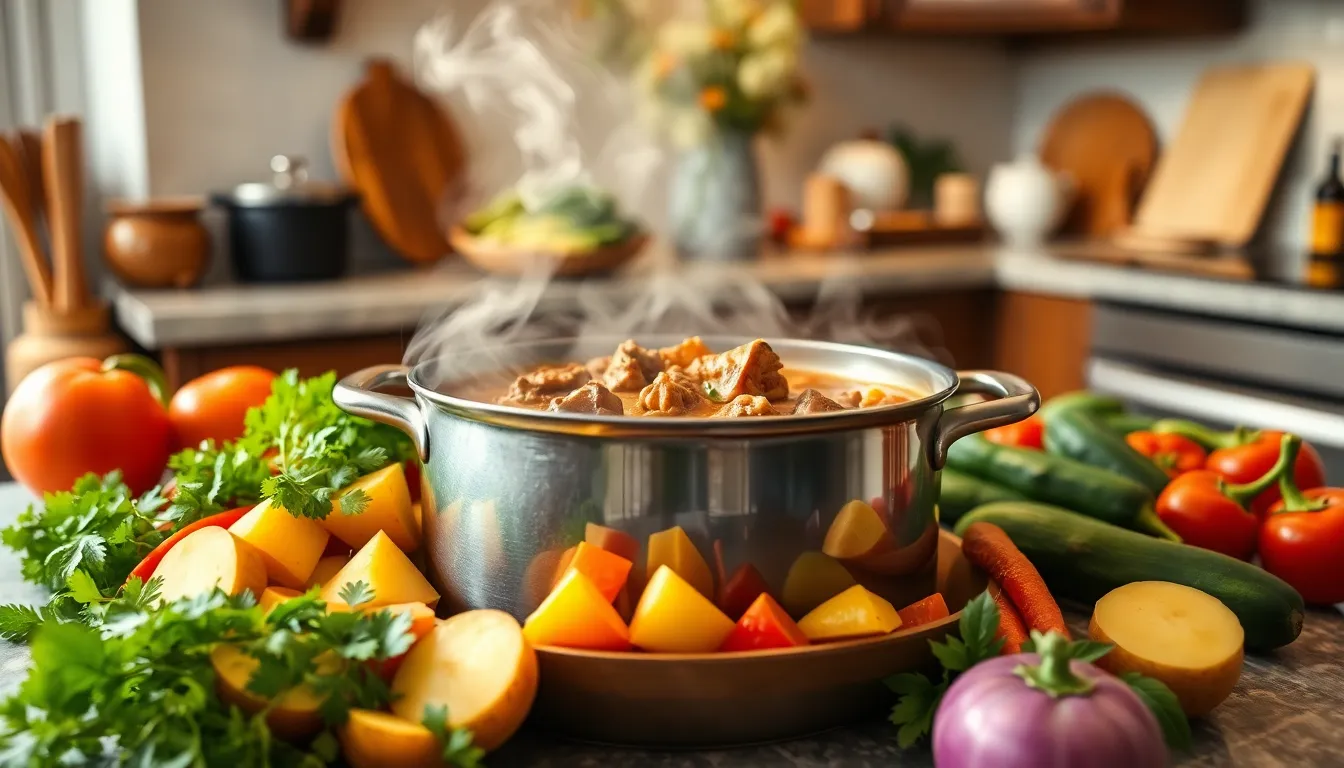
Chinese beef curry transforms into an even more spectacular dish when prepared in advance. The complex spice blend develops deeper layers of flavor during overnight refrigeration while the beef becomes increasingly tender.
Preparing Curry in Advance
We recommend cooking the entire curry 1-2 days before serving for optimal flavor development. Allow the finished curry to cool completely at room temperature before transferring to storage containers. The cooling process typically takes 30-45 minutes depending on the batch size.
Store the cooled curry in airtight containers in the refrigerator for up to 4 days. Glass containers work exceptionally well as they prevent flavor absorption and make reheating easier. Label containers with preparation dates to track freshness.
Freezing Guidelines
Long-term storage becomes simple with proper freezing techniques. Transfer completely cooled curry to freezer-safe containers leaving 1 inch of headspace for expansion. We suggest portioning the curry into meal-sized containers for convenient thawing.
| Storage Method | Duration | Container Type |
|---|---|---|
| Refrigerator | 3-4 days | Airtight containers |
| Freezer | 2-3 months | Freezer-safe containers |
| Portion sizes | 2-4 servings | Individual containers |
Frozen curry maintains its quality for up to 3 months when stored at 0°F or below. Vacuum-sealed bags offer another excellent freezing option that saves freezer space.
Reheating Best Practices
Thaw frozen curry overnight in the refrigerator for even reheating. Never thaw at room temperature as this compromises food safety and texture quality.
Reheat refrigerated curry gently on the stovetop over medium-low heat stirring occasionally. Add 2-3 tablespoons of beef broth or water if the sauce appears too thick after storage. The reheating process takes 8-10 minutes for refrigerated curry.
Frozen curry can be reheated directly from frozen using low heat and frequent stirring. This method requires 15-20 minutes and careful attention to prevent scorching the bottom. Steam trapped during freezing will release during reheating so expect some initial splattering.
Make-Ahead Preparation Tips
Prepare vegetables up to 24 hours in advance by storing cut potatoes in cold water and other vegetables in sealed containers. This technique saves important time on serving day while maintaining vegetable freshness.
We suggest preparing extra portions since the improved flavor after resting makes leftovers highly desirable. The curry actually tastes better on the second day as the spices fully integrate with the beef and vegetables.
Conclusion
We’ve given you everything you need to create an authentic Chinese beef curry that’ll become a staple in your kitchen. This recipe delivers restaurant-quality results with simple techniques and ingredients you can easily find.
The beauty of this dish lies in its versatility and make-ahead convenience. Whether you’re preparing it for a weeknight dinner or entertaining guests the flavors only get better with time. The tender beef rich sauce and perfectly cooked vegetables create a satisfying meal that’s both comforting and impressive.
Now it’s time to gather your ingredients fire up that Dutch oven and experience the incredible aromas that’ll fill your kitchen. Trust us – once you taste this homemade Chinese beef curry you’ll never want to order takeout again.
Frequently Asked Questions
What makes Chinese beef curry different from Indian curry?
Chinese beef curry has a unique flavor profile that’s less spicy and more savory than traditional Indian curries. It uses Chinese curry powder, coconut milk, and soy sauce to create a milder, slightly sweet taste. The cooking technique focuses on slow braising to achieve tender beef and a rich, stew-like consistency that’s distinctly Chinese in character.
What cut of beef works best for Chinese beef curry?
Chuck roast is the ideal cut for Chinese beef curry because it contains the perfect balance of fat and connective tissue. When slow-cooked, these tough fibers break down into tender, flavorful meat. Cut the chuck roast into uniform 2-inch cubes and marinate with baking soda for extra tenderness before cooking.
How long does it take to cook Chinese beef curry?
The total cooking time is approximately 1.5 to 2 hours, including preparation. After browning the beef and building the curry base, the dish needs to simmer for about 1 hour to tenderize the meat. Vegetables are added during the last 20-30 minutes to ensure they’re perfectly cooked without becoming mushy.
Can I make Chinese beef curry ahead of time?
Yes, Chinese beef curry is perfect for make-ahead preparation. The flavors actually improve after 1-2 days in the refrigerator. Store cooled curry in airtight containers for 3-4 days refrigerated, or freeze for up to 2 months. Reheat gently on the stovetop, adding a splash of broth if needed.
What equipment do I need to make Chinese beef curry?
You’ll need a heavy-bottomed pot or Dutch oven for even heat distribution during slow cooking. Basic kitchen tools include sharp knives, cutting boards, measuring spoons, mixing bowls, and wooden spoons. Most home kitchens already have these items, so no special equipment purchases are necessary for this recipe.
How do I achieve the perfect curry consistency?
The ideal consistency is achieved using a cornstarch slurry mixed with coconut milk. Start with 2 tablespoons of cornstarch mixed with cold water, then gradually add to the simmering curry. The sauce should coat the back of a spoon but still flow easily. Adjust with additional broth or cornstarch as needed.
What vegetables work well in Chinese beef curry?
Traditional vegetables include potatoes, carrots, and bell peppers. You can also add onions, mushrooms, or baby corn for variety. Cut vegetables into uniform sizes and add them during the last 20-30 minutes of cooking to maintain their texture and prevent overcooking.
How should I store and reheat leftover Chinese beef curry?
Store cooled curry in airtight containers in the refrigerator for 3-4 days. For freezing, use freezer-safe containers for up to 2 months. Reheat refrigerated curry gently on the stovetop over medium-low heat. Thaw frozen curry overnight in the refrigerator before reheating, stirring occasionally to ensure even heating.

